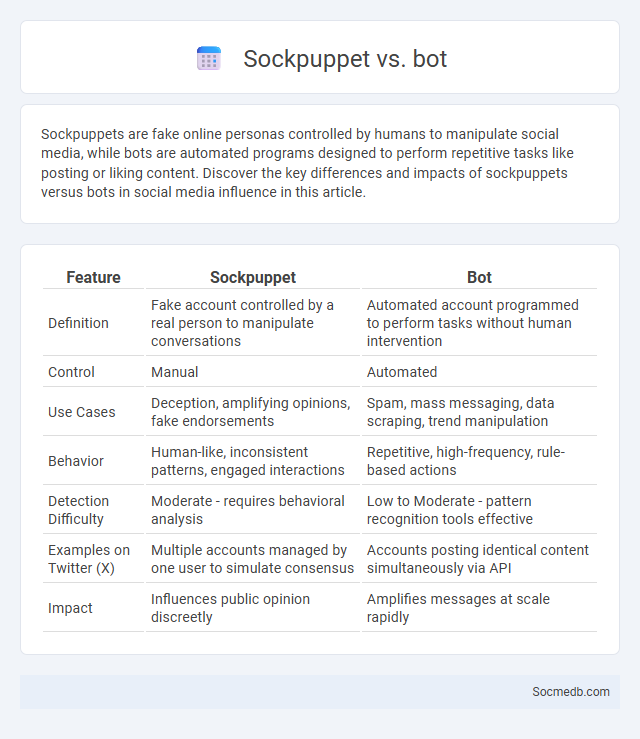
Photo illustration: Sockpuppet vs Bot
Sockpuppets are fake online personas controlled by humans to manipulate social media, while bots are automated programs designed to perform repetitive tasks like posting or liking content. Discover the key differences and impacts of sockpuppets versus bots in social media influence in this article.
Table of Comparison
| Feature | Sockpuppet | Bot |
|---|---|---|
| Definition | Fake account controlled by a real person to manipulate conversations | Automated account programmed to perform tasks without human intervention |
| Control | Manual | Automated |
| Use Cases | Deception, amplifying opinions, fake endorsements | Spam, mass messaging, data scraping, trend manipulation |
| Behavior | Human-like, inconsistent patterns, engaged interactions | Repetitive, high-frequency, rule-based actions |
| Detection Difficulty | Moderate - requires behavioral analysis | Low to Moderate - pattern recognition tools effective |
| Examples on Twitter (X) | Multiple accounts managed by one user to simulate consensus | Accounts posting identical content simultaneously via API |
| Impact | Influences public opinion discreetly | Amplifies messages at scale rapidly |
Introduction: Understanding Online Identity Manipulation
Online identity manipulation involves deliberately altering or fabricating personal information on social media platforms to influence perception, behavior, or access. This practice includes creating fake profiles, impersonating others, or modifying existing identities for social, financial, or political gain. Recognizing patterns of identity manipulation is crucial for protecting privacy and maintaining digital trust in increasingly interconnected digital environments.
What Is a Sockpuppet?
A sockpuppet is a fake online identity created to manipulate public opinion, deceive others, or amplify certain viewpoints on social media platforms. These accounts, often controlled by a single person or group, engage in activities such as posting misleading comments, spreading false information, or boosting content artificially to influence discussions. Protecting Your online reputation involves recognizing and reporting sockpuppet accounts to maintain genuine interaction and trust across social networks.
Defining Bots: Automated Online Entities
Bots are automated software programs designed to perform specific tasks on social media platforms, such as posting content, liking, commenting, or following users. These online entities operate without human intervention, enabling large-scale interactions and data collection at high speed. Understanding the role of bots is essential for addressing issues like spam, misinformation, and audience engagement strategies.
Key Differences Between Sockpuppets and Bots
Sockpuppets on social media are fake personas controlled by humans to manipulate discussions or create false support, while bots are automated programs designed to perform repetitive tasks such as liking, sharing, or posting content. Sockpuppets usually engage in nuanced interactions and can adapt their behavior, whereas bots follow pre-set algorithms and lack genuine conversation skills. Understanding these differences helps you identify deceptive activities and maintain authentic engagement on your social platforms.
Common Tactics Used by Sockpuppets
Sockpuppets on social media commonly employ tactics such as creating fake profiles to manipulate public opinion, posting misleading or biased content to promote specific agendas, and engaging in coordinated interactions to amplify false narratives. These deceptive accounts often use repetitive messaging, fake endorsements, and fabricated supporter networks to influence discussions and distort genuine user sentiment. Protecting Your online presence requires vigilance against these strategies to maintain authentic interactions and credible information.
How Bots Influence Online Conversations
Bots significantly shape online conversations by amplifying specific content and creating artificial trends, which can distort public perception and influence user opinions. Automated accounts generate and spread vast amounts of information rapidly, often drowning out genuine human voices and skewing social media algorithms. Understanding how bots manipulate these platforms helps you critically evaluate the authenticity and diversity of online discourse.
Sockpuppet vs Sockpuppet: Multiple Personas Explained
Sockpuppets on social media refer to fake accounts created by the same individual to manipulate opinions or evade bans, while multiple personas involve distinct online identities maintained for different purposes but controlled by one user. Sockpuppets often aim to deceive by amplifying one viewpoint or spreading misinformation, whereas managing multiple personas can serve legitimate needs like separating personal and professional lives. Understanding the differences between sockpuppets and multiple personas is crucial for detecting coordinated inauthentic behavior and protecting online community integrity.
Spotting Sockpuppets and Bots in Online Communities
Spotting sockpuppets and bots in online communities involves identifying patterns such as identical posting styles, repetitive content, and unusually high activity levels from a single user or IP address. Analyzing metadata like account creation dates, follower ratios, and interaction timestamps can reveal inauthentic behavior. Leveraging AI-driven tools and machine learning algorithms enhances detection accuracy, protecting social media platforms from manipulation and misinformation.
The Impact of Sockpuppets and Bots on Digital Trust
Sockpuppets and bots undermine digital trust by spreading misinformation and creating fake engagement, which distorts your perception of authentic online interactions. These automated accounts manipulate social media algorithms, inflating popularity metrics and misleading users about genuine public opinion. Combatting such deceptive practices is essential to preserving the integrity and reliability of your digital environment.
Preventing and Mitigating Online Manipulation
Online manipulation techniques exploit algorithms and user psychology to spread misinformation and influence behavior. Strengthening your digital literacy by recognizing misleading content and verifying sources reduces the risk of falling victim to manipulation. Platforms implementing AI-driven detection systems and transparency measures play a crucial role in mitigating the impact of deceptive online tactics.
 socmedb.com
socmedb.com